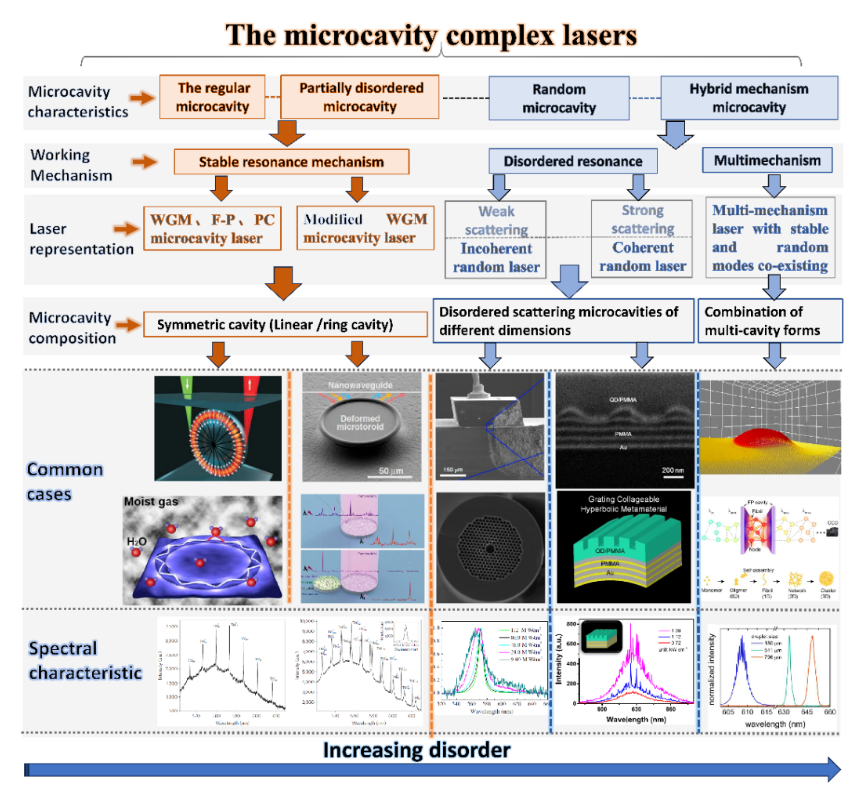Microcavity complex lasers from ordered to disordered states
A typical laser consists of three basic elements: a pump source, a gain medium that amplifies the stimulated radiation, and a cavity structure that generates an optical resonance. When the cavity size of the laser is close to the micron or submicron level, it has become one of the current research hotspots in the academic community: microcavity lasers, which can achieve significant light and matter interaction in a small volume. Combining microcavities with complex systems, such as introducing irregular or disordered cavity boundaries, or introducing complex or disordered working media into microcavities, will increase the degree of freedom of laser output. The physical non-cloning characteristics of disordered cavities bring multidimensional control methods of laser parameters, and can expand its application potential.
Different systems of random microcavity lasers
In this paper, random microcavity lasers are classified from different cavity dimensions for the first time. This distinction not only highlights the unique output characteristics of the random microcavity laser in different dimensions, but also clarifies the advantages of the size difference of the random microcavity in various regulatory and application fields. The three-dimensional solid-state microcavity usually has a smaller mode volume, thus achieving a stronger light and matter interaction. Due to its three-dimensional closed structure, the light field can be highly localized in three dimensions, often with a high quality factor (Q-factor). These characteristics make it suitable for high-precision sensing, photon storage, quantum information processing and other advanced technology fields. The open two-dimensional thin film system is an ideal platform for constructing disordered planar structures. As a two-dimensional disordered dielectric plane with integrated gain and scattering, the thin film system can actively participate in the generation of random laser. The planar waveguide effect makes the laser coupling and collection easier. With the cavity dimension further reduced, the integration of feedback and gain media into the one-dimensional waveguide can suppress radial light scattering while enhancing axial light resonance and coupling. This integration approach ultimately improves the efficiency of laser generation and coupling.
Regulatory characteristics of random microcavity lasers
Many indicators of traditional lasers, such as coherence, threshold, output direction and polarization characteristics, are the key criteria to measure the output performance of lasers. Compared with conventional lasers with fixed symmetric cavities, the random microcavity laser provides more flexibility in parameter regulation, which is reflected in multiple dimensions including time domain, spectral domain and spatial domain, highlighting the multi-dimensional controllability of random microcavity laser.
Application characteristics of random microcavity lasers
Low spatial coherence, mode randomness and sensitivity to environment provide many favorable factors for the application of stochastic microcavity lasers. With the solution of mode control and direction control of random laser, this unique light source is increasingly used in imaging, medical diagnosis, sensing, information communication and other fields.
As a disordered micro-cavity laser at micro and nano scale, the random microcavity laser is very sensitive to environmental changes, and its parametric characteristics can respond to various sensitive indicators monitoring the external environment, such as temperature, humidity, pH, liquid concentration, refractive index, etc., creating a superior platform for realizing high-sensitivity sensing applications. In the field of imaging, the ideal light source should have high spectral density, strong directional output and low spatial coherence to prevent interference speckle effects. The researchers demonstrated the advantages of random lasers for speckle free imaging in perovskite, biofilm, liquid crystal scatterers and cell tissue carriers. In medical diagnosis, random microcavity laser can carry scattered information from biological host, and has been successfully applied to detect various biological tissues, which provides convenience for non-invasive medical diagnosis.
In the future, systematic analysis of disordered microcavity structures and complex laser generation mechanisms will become more complete. With the continuous progress of materials science and nanotechnology, it is expected that more fine and functional disordered microcavity structures will be manufactured, which has great potential in promoting basic research and practical applications.

Post time: Nov-05-2024





